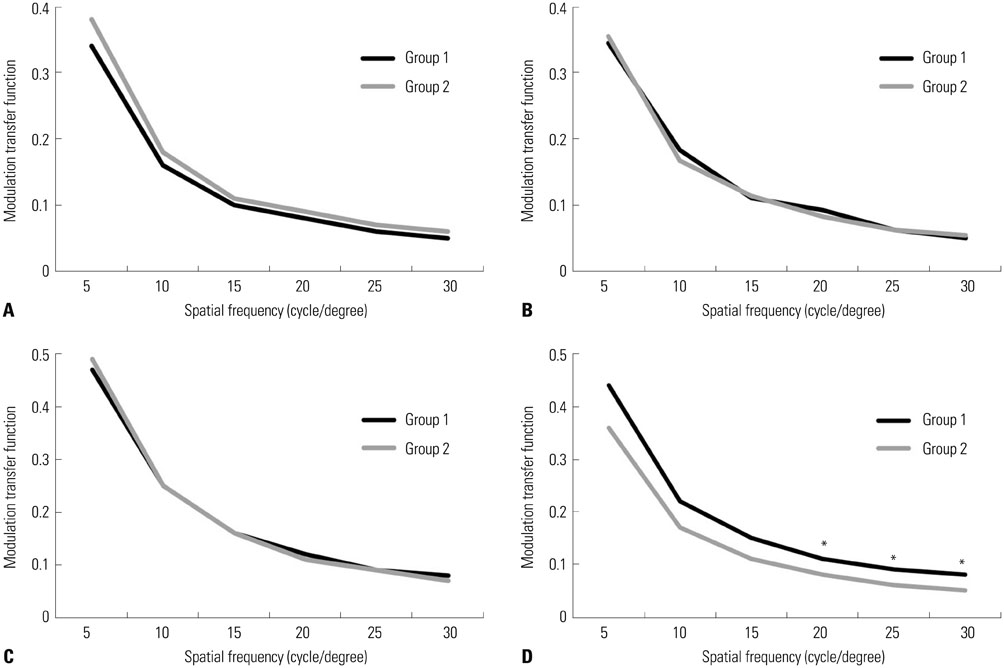Yonsei Med J.
2016 Sep;57(5):1236-1242. 10.3349/ymj.2016.57.5.1236.
Effect of Co-Implantation of a Capsular Tension Ring on Clinical Outcomes after Cataract Surgery with Monofocal Intraocular Lens Implantation
- Affiliations
-
- 1The Institute of Vision Research, Department of Ophthalmology, Yonsei University College of Medicine, Seoul, Korea. tikim@yuhs.ac
- 2Department of Ophthalmology, International St. Mary's Hospital, Catholic Kwandong University College of Medicine, Incheon, Korea.
- 3Corneal Dystrophy Research Institute, Severance Biomedical Science Institute, and Brain Korea 21 Plus Project for Medical Science, Yonsei University College of Medicine, Seoul, Korea.
- KMID: 2374171
- DOI: http://doi.org/10.3349/ymj.2016.57.5.1236
Abstract
- PURPOSE
The objective was to evaluate the effect of co-implantation of a preloaded capsular tension ring (CTR) and aberration-free monofocal intraocular lens (IOL) on clinical outcomes and visual quality after cataract surgery.
MATERIALS AND METHODS
Patients who underwent cataract surgery were randomized into two groups that were implanted with a CTR and IOL (group 1, 26 eyes) or an IOL only (group 2, 26 eyes). At 1 and 3 months after surgery, visual acuity, refractive errors, refractive prediction errors, ocular aberrations, and modulation transfer function (MTF) were analyzed. At 3 months postoperatively, anterior chamber depth (ACD) and contrast sensitivity were evaluated.
RESULTS
Group 1 showed greater hyperopic shift, which caused the refractive prediction error at 3 months after surgery to be significantly different between the two groups (p=0.049). Differences in ACD between the preoperative and postoperative periods tended to be greater in group 1 than in group 2. At 3 months postoperatively, internal MTF values at 20, 25, and 30 cycles per degree were significantly better in group 1 than in group 2 (p=0.034, 0.017, and 0.017, respectively). Contrast sensitivity showed comparable results at almost all spatial frequencies between the groups.
CONCLUSION
Regarding visual acuity and quality, both groups showed comparable results. Co-implantation of a CTR and aberration-free monofocal IOL was associated with hyperopic refractive outcomes. Surgeons should consider the position of the IOL when planning co-implantation of a CTR and IOL.
MeSH Terms
Figure
Reference
-
1. Boomer JA, Jackson DW. Effect of the Morcher capsular tension ring on refractive outcome. J Cataract Refract Surg. 2006; 32:1180–1183.
Article2. Ahmed II, Cionni RJ, Kranemann C, Crandall AS. Optimal timing of capsular tension ring implantation: Miyake-Apple video analysis. J Cataract Refract Surg. 2005; 31:1809–1813.
Article3. Alió JL, Elkady B, Ortiz D, Bernabeu G. Microincision multifocal intraocular lens with and without a capsular tension ring: optical quality and clinical outcomes. J Cataract Refract Surg. 2008; 34:1468–1475.
Article4. Schild AM, Rosentreter A, Hellmich M, Lappas A, Dinslage S, Dietlein TS. Effect of a capsular tension ring on refractive outcomes in eyes with high myopia. J Cataract Refract Surg. 2010; 36:2087–2093.
Article5. Retzlaff JA, Sanders DR, Kraff MC. Development of the SRK/T intraocular lens implant power calculation formula. J Cataract Refract Surg. 1990; 16:333–340.
Article6. KüÇüksümer Y, Bayraktar S, Sahin S, Yilmaz OF. Posterior capsule opacification 3 years after implantation of an AcrySof and a MemoryLens in fellow eyes. J Cataract Refract Surg. 2000; 26:1176–1182.
Article7. Kurz S, Krummenauer F, Hacker P, Pfeiffer N, Dick HB. Capsular bag shrinkage after implantation of a capsular bending or capsular tension ring. J Cataract Refract Surg. 2005; 31:1915–1920.
Article8. Mastropasqua R, Toto L, Vecchiarino L, Falconio G, Nicola MD, Mastropasqua A. Multifocal IOL implant with or without capsular tension ring: study of wavefront error and visual performance. Eur J Ophthalmol. 2013; 23:510–517.
Article9. Lee DH, Lee HY, Lee KH, Chung KH, Joo CK. Effect of a capsular tension ring on the shape of the capsular bag and opening and the intraocular lens. J Cataract Refract Surg. 2001; 27:452–456.
Article10. Jacob S, Agarwal A, Agarwal A, Agarwal S, Patel N, Lal V. Efficacy of a capsular tension ring for phacoemulsification in eyes with zonular dialysis. J Cataract Refract Surg. 2003; 29:315–321.
Article11. Landers J, Liu H. Choice of intraocular lens may not affect refractive stability following cataract surgery. Clin Experiment Ophthalmol. 2005; 33:34–40.
Article12. Heiner P, Ligabue E, Fan A, Lam D. Safety and effectiveness of a single-piece hydrophobic acrylic intraocular lens (enVista®) - results of a European and Asian-Pacific study. Clin Ophthalmol. 2014; 8:629–635.13. Crnej A, Buehl W, Greslechner R, Hirnschall N, Findl O. Effect of an aspheric intraocular lens on the ocular wave-front adjusted for pupil size and capsulorhexis size. Acta Ophthalmol. 2014; 92:e353–e357.
Article14. Rozema JJ, Koppen C, de Groot V, Tassignon MJ. Influence of neodymium:YAG laser capsulotomy on ocular wavefront aberrations in pseudophakic eyes with hydrophilic and hydrophobic intraocular lenses. J Cataract Refract Surg. 2009; 35:1906–1910.
Article
- Full Text Links
- Actions
-
Cited
- CITED
-
- Close
- Share
- Similar articles
-
- The Effect of Capsular Tension Ring on Posterior Capsular Opacity in Cataract Surgery
- Phacoemulsification and Intraocular Lens Implantation using the Capsular Tension Ring
- The Effect of Capsular Tension Ring on Posterior Capsular Opacity in Cataract Surgery
- The effect of the haptic portion of intraocular lens on the development of posterior capsular opacification in rabbit
- Intraocular Pressure Changes in the Uneventful Extra-capsular Cataract Extraction and Extra-capsular Cataract Extraction with Vitreous Loss followed by Anterior Chamber Lens Implantation



